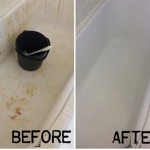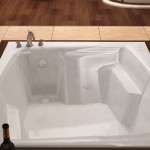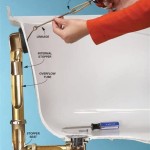How to Clean a Bathtub with Vinegar and Baking Soda
Maintaining a clean bathroom is essential for hygiene and overall home aesthetics. A particularly challenging area to keep clean is the bathtub, often subjected to soap scum, hard water stains, mildew, and general grime accumulation. While numerous commercial cleaning products are available, a natural and effective alternative lies in utilizing vinegar and baking soda, two readily available household items. This article provides a comprehensive guide on how to clean a bathtub effectively using these ingredients, outlining the steps, considerations, and benefits involved.
The combination of vinegar and baking soda creates a powerful cleaning action due to their contrasting chemical properties. Baking soda, also known as sodium bicarbonate, is a mild alkali with abrasive properties. It helps to loosen dirt and grime without scratching the bathtub surface. Vinegar, on the other hand, is a weak acid (acetic acid) that effectively dissolves mineral deposits like hard water stains and soap scum. When combined, they react to produce carbon dioxide gas, which further lifts away dirt and debris. This reaction necessitates proper ventilation and caution during the cleaning process.
Preparing for Cleaning
Before commencing the cleaning process, gathering all necessary materials is crucial. This ensures an efficient and uninterrupted cleaning experience. The required supplies include:
*White Vinegar:
This is the primary cleaning agent for dissolving mineral deposits and soap scum. Ensure it is standard white vinegar with approximately 5% acetic acid. *Baking Soda:
This serves as a mild abrasive and helps to lift dirt and grime. A fresh box ensures optimal effectiveness. *Spray Bottle:
Used for dispensing the vinegar evenly over the bathtub surface. *Cleaning Cloths or Sponges:
These are essential for scrubbing and wiping down the bathtub. *Scrub Brush (Optional):
A scrub brush with stiff bristles can be helpful for tackling stubborn stains or hard-to-reach areas. *Rubber Gloves:
Protect hands from prolonged exposure to vinegar and baking soda, especially for individuals with sensitive skin. *Water:
Used for rinsing the bathtub after cleaning. *Ventilation:
Ensuring adequate airflow in the bathroom is paramount. Open windows and turn on the exhaust fan to dissipate fumes and prevent irritation.Once the materials are assembled, the bathtub should be prepped for cleaning. Remove any items from the bathtub, such as shampoo bottles, soap dishes, or bath toys. A quick rinse with water can help to loosen any loose dirt or debris, making the subsequent cleaning process more effective.
The Cleaning Process: A Step-by-Step Guide
The cleaning process involves several steps, each contributing to the overall cleanliness of the bathtub. Adhering to these steps ensures optimal results and minimizes potential damage to the bathtub surface.
Step 1: Vinegar Application:
Pour white vinegar into the spray bottle and liberally spray the entire surface of the bathtub, including the walls, floor, and faucet fixtures. Ensure that all areas are thoroughly saturated with vinegar. For particularly stubborn stains, consider focusing the spray directly on those areas.Step 2: Vinegar Soak:
Allow the vinegar to soak on the bathtub surface for approximately 30 minutes. This allows the acetic acid in the vinegar to penetrate and loosen the soap scum, hard water stains, and mildew. For heavily soiled bathtubs, the soaking time can be extended to an hour or even overnight. It is imperative to maintain adequate ventilation during this soaking period.Step 3: Baking Soda Application:
After the vinegar has soaked, sprinkle baking soda generously over the entire wet surface of the bathtub. The baking soda will react with the vinegar, creating a fizzing action. This reaction helps to lift dirt and grime from the surface.Step 4: Scrubbing:
Using a cleaning cloth, sponge, or scrub brush, thoroughly scrub the entire bathtub surface. Pay close attention to areas with stubborn stains or heavy buildup. The abrasive properties of the baking soda, combined with the dissolving action of the vinegar, will help to remove the dirt and grime. Apply moderate pressure while scrubbing to avoid scratching the bathtub surface, especially if it is made of acrylic or fiberglass.Step 5: Rinsing:
After scrubbing, thoroughly rinse the bathtub with warm water. Ensure that all traces of baking soda and vinegar are removed. Use a showerhead or a bucket of water to effectively rinse all surfaces of the bathtub. Inspect the bathtub for any remaining stains or residue. If necessary, repeat steps 3 and 4 to address stubborn areas.Step 6: Drying:
Once the bathtub is thoroughly rinsed, use a clean, dry cloth or towel to dry the entire surface. This helps to prevent water spots and further buildup of soap scum. Drying the bathtub after each use can significantly reduce the frequency of deep cleaning.Addressing Specific Cleaning Challenges
Certain areas or types of stains may require specialized attention during the cleaning process. These include:
*Hard Water Stains:
These stains are often white or chalky in appearance and are caused by mineral deposits from hard water. For stubborn hard water stains, consider soaking a cloth or sponge in vinegar and placing it directly on the stain for several hours before scrubbing. *Soap Scum:
This is a greasy buildup that results from the combination of soap, body oils, and hard water. A paste of baking soda and water can be applied directly to the soap scum and allowed to sit for a few minutes before scrubbing. *Mildew:
Mildew is a type of mold that thrives in damp environments. For mildew stains, a solution of equal parts vinegar and water can be sprayed on the affected area and allowed to sit for several minutes before scrubbing. In severe cases, a stronger solution of bleach and water may be necessary, but it is crucial to exercise caution when using bleach and ensure adequate ventilation. When using bleach, NEVER mix it with vinegar, as this creates toxic chlorine gas. *Faucet Fixtures:
The faucet fixtures can also accumulate mineral deposits and soap scum. Use a soft cloth or sponge dipped in vinegar to clean the fixtures. A toothbrush can be used to clean hard-to-reach areas around the base of the faucet. *Grout:
The grout lines between tiles can be particularly challenging to clean. A paste of baking soda and water can be applied to the grout lines and scrubbed with a grout brush or an old toothbrush.Considerations and Precautions
While vinegar and baking soda are generally safe and effective cleaning agents, certain considerations and precautions should be observed:
*Ventilation:
Ensure adequate ventilation in the bathroom during the cleaning process. The fumes from vinegar can be irritating to the respiratory system, especially for individuals with asthma or other respiratory conditions. Opening windows and turning on the exhaust fan can help to dissipate the fumes. *Surface Sensitivity:
Some bathtub surfaces, such as certain types of natural stone or delicate enamel, may be sensitive to acidic cleaners like vinegar. Always test the vinegar on a small, inconspicuous area of the bathtub before applying it to the entire surface. If any discoloration or damage occurs, discontinue use. *Mixing with Bleach:
Never mix vinegar with bleach. This combination creates toxic chlorine gas, which can be harmful or even fatal if inhaled. If bleach is necessary for cleaning mildew, use it separately from vinegar and ensure adequate ventilation. *Skin Sensitivity:
Prolonged exposure to vinegar and baking soda can irritate the skin. Wear rubber gloves to protect hands during the cleaning process. *Eye Contact:
Avoid getting vinegar or baking soda in the eyes. If contact occurs, rinse thoroughly with water. *Frequency of Cleaning:
The frequency of cleaning depends on the usage of the bathtub and the severity of buildup. A weekly cleaning with vinegar and baking soda can help to prevent the accumulation of soap scum and hard water stains. For heavily used bathtubs, more frequent cleaning may be necessary.Benefits of Using Vinegar and Baking Soda
Using vinegar and baking soda as cleaning agents offers several benefits compared to commercial cleaning products:
*Natural and Non-Toxic:
Vinegar and baking soda are natural and non-toxic, making them a safer alternative to commercial cleaning products that often contain harsh chemicals. *Environmentally Friendly:
Vinegar and baking soda are biodegradable and do not contribute to environmental pollution. *Cost-Effective:
Vinegar and baking soda are readily available and relatively inexpensive compared to commercial cleaning products. *Effective Cleaning:
The combination of vinegar and baking soda provides effective cleaning action, removing soap scum, hard water stains, and mildew. *Reduced Allergens:
Using natural cleaning agents can help to reduce allergens in the home, benefiting individuals with sensitivities or allergies.Maintaining a Clean Bathtub
Regular maintenance can significantly reduce the need for deep cleaning and keep the bathtub looking its best. Consider the following tips:
*Rinse After Each Use:
Rinse the bathtub with water after each use to remove soap residue and prevent the buildup of soap scum. *Dry After Each Use:
Wipe down the bathtub with a clean, dry cloth after each use to prevent water spots and further buildup of soap scum. *Ventilation:
Ensure adequate ventilation in the bathroom to prevent the growth of mildew. *Squeegee:
Use a squeegee to remove water from the bathtub walls and floor after each use. *Regular Cleaning:
Perform a weekly cleaning with vinegar and baking soda to prevent the accumulation of soap scum and hard water stains.How To Clean Your Tub Naturally Even When It S Really Gross Note Trash

How I Clean My Bathtub Dawn Baking Soda Vinegar Does It Work

Tried And Twisted Myth Or Miracle Cleaner Series Clean Your Bath Tub With Vinegar

3 Ingredient Magic Tub Cleaner No Scrub Low Odor Natural Ish Hometalk

Show Your Bathroom Some Love With Baking Soda Vinegar And Soap

How To Clean Tub Shower With Baking Soda Vinegar Best Bathtub Cleaning Brush

How To Deep Clean Your Bathtub Nw Maids

How To Clean Tough Stains From A Bathtub 4 Easy Methods
:max_bytes(150000):strip_icc()/SPR-freshen-and-unclog-drain-with-baking-soda-1900466-Final-8fa0efccc89b48cc91da010f44f77e05.png?strip=all)
How To Unclog A Drain With Baking Soda And Vinegar

How To Clean Your Bathtub The Home Depot
Related Posts








